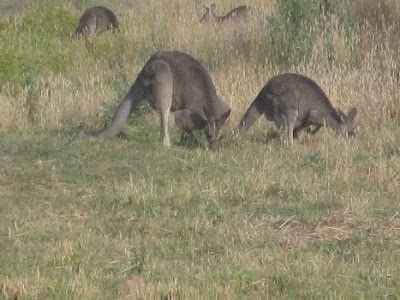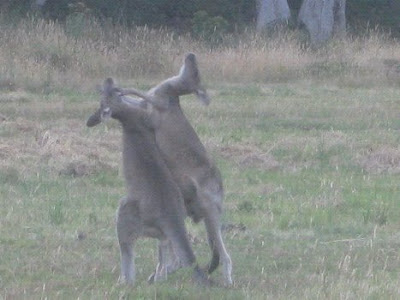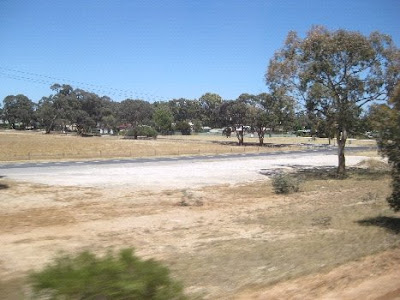Our 6 days in the campervan turned out to be very comfortable – although if we ever bought one it would be just a little longer. We explored the Yarra Range hills and the Dandenung Hills to the north-east of Melbourne and enjoyed some superb walks which were pretty devoid of people despite it being the peak holiday season
Returning the camper, collecting the 'new' hire car and fitting in an evening session at the Australian Open to see Andy Murray required all of Meg's organisational skills (as we are no longer able to carry with us all our baggage). However, it was well worth going to the tennis which had been one of our hopes for the trip.
Murray in the Open
I should tell you a little about our car. It was a 1990 Toyota Camry which we found via yellow pages and lots of phone calls. The cost of two months hire was about £500 compared with about £2000 for a normal car hire, but the car is not exactly in mint condition. With 277000 kilometers on the clock and, clearly having experienced a car-cleaning regime that rivals our own, it is unlikely to ever be stolen – and if we bang into something it won't show.
So we set off on our journey towards Brisbane with some concerns about vehicle reliability – heading for Bairnsdale on the South-East coast of Victoria. At 35 degrees it soon became apparent that the air-con did not work. We began to feel a little concerned and as perspiration dripped off Meg, and sweat ran down my neck, we thought about the temperatures in NSW and Queensland. Meg, adopting her assertive character phoned our friendly car-hire man, Michael, who confirmed that the a/c didn't work but then we never asked for a/c. Meg's answer of “well we assumed that a/c was standard on a Camry of that year” was wonderful (I should point out that Meg's knowledge of car specifications is one of her weaker subject areas in Pub quizzes). Michael had to agree but we were still in the same boat (or car).
About 30 minutes later Michael rang back with the offer of another Camry which did have a/c, available in a few days time. “The bodywork isn't as good – not that your one has good bodywork” suggested that there might be other issues to consider but we decided to go with it, although it meant returning to Melbourne (350 km).
We spent two days at Bairnsdale and found a magnificent walk in the Mitchell River National Park, and then hit the Road for Mebourne yet again.
The Mitchell River
We used the two days to the best advantage - tickets for the Australian Open were still available and our hotel could fit us in (only 400m from the Rod Laver arena – like finding a TraveLodge at Wimbledon) so we decided to blow some of the savings on the car hire by going to the tennis for two more sessions. Our first session saw Murray lose (on the big screen inside the ground), Tsonga beat Blake, Nadal destroy Gonzales, Safina beat Dokic and best of all we saw Federer utterly humiliate Del Potro. Watching Federer was wonderful - his poise and movement were just remarkable – but the Dokic game had all the atmosphere. She is Australian so it was like watching Henman at Wimbledon.
Tuesday we picked up the 'new' car. Michael was right – the body was not as good, but the a/c/ did work (only on the highest fan setting – but thats all we needed). In fact the car seemed pretty good all round for a vehicle that had travelled 360000km. As we set off on Wednesday morning, along the Hume Highway towards Sydney we began to pick up radio reports of a massive heatwave that was due to hit Victoria over the next few days. Even with a/c the car was warm and outside the air soon reached temperatures that are similar to those you get in Death Valley. In fact the temperature in the shade reached 44/45 degrees over the next 4 days, dropping to about 25-30 at night. Camping in a tent is great but not at those temperatures! We once again opted for air-conditioned cabins.
For those of you who know our feelings about global warming might well wonder why we aren't simply going with the flow and coping with the high temperatures. If thats the case you probably have never experienced extreme temperatures without air conditioning. A/c is just as vital as heat is at low temperatures – and we have our central heating on in the winter just like everyone else. What is interesting is that a/c is needed just at the time when the sun is brightest and it would seem that solar power (photovoltaics) would be a really good source of electricity in these circumstances. Perhaps one day these a/c units will only be sold with the attached solar array to power them.
So in Melbourne over the next few days the heat wave reached levels never before experienced, bush fires raged in the South Eastern suburbs and there were lots of power outages. The Casino lift stopped working and Federer had to walk down 30 floors to get out. Good job he is in reasonable condition.
Fire is an ever present concern in the summer here and fire-fighters, most of whom are volunteers, have a status similar to lifeboat crews in the UK. They do an amazing job and many lose their lives each year. The land becomes so dry that it takes only one match to set off a fire that can destroy thousands of square miles of grassland and forest. The trees being Eucalyptus produce oils and the heat of the fire creates a cloud of flammable oils high in the forest canopy. The flames can then jump from tree to tree at tree-top height. I still don't understand how they stop the fires and why Australia is not completely burned down. You often see the results of bush fires from previous years, where recovery is still taking place. In some cases it takes 50 years for a forest to recover, in others only a few.
During the heatwave we tended to go high up in the mountains where the temperatures were about 10 degrees lower (only 33!) and walk there in the mornings before the heat reached its peak. So we headed into what is called the Alpine Region of North Victoria which becomes the Snowy Mountains just over the border in New South Wales. This had been part of our original thinking but was an essential survival strategy with the temperature over 40 degrees in the valleys. Perhaps we were the only ones foolhardy enough to do anything, but we rarely saw anyone else walking and were rewarded for our efforts with views across the Great Dividing Range that were utterly stunning.
Occasionally in the afternoons we would plonk ourselves by an “alpine” lake and swim or read our books, (if we could get some shade).
Mount Buffallo
Lake Catani
Falls Creek
Rocky Valley
The routes in the mountains are spectacular – as good as anything we have come across in Europe or North America. Considering the low usage (there are usually empty) and the distances involved, the upkeep must be very expensive.
Workmen appear spontaneously when trees fall across the road ...
We continued our wild-life adventures, spotting a wild puma in Porepunka.
The first sighting of a Puma in Victoria
A little later, by the time it had reached us it turned out to be just a large moggie!
What was interesting was how much larger it seemed when viewed from a distance – perhaps that might explain some of the puma sightings around Gloucestershire.
Another remarkable encounter ... in the car park in Thredbo. Jeff threw a stick at an obnoxious crow that had just pecked our shopping bag. The next morning we returned to the car to find the most amazing volume of bird-droppings – possibly the largest in Australia – covering every available space on the roof, bonnet, boot and windows. Fortunately there was no possibility of it damaging the paintwork any further.
The climax of our walking was to reach the top of Mount Kosciuszko, the highest peak in Australia. It turned out to be one of the easiest mainly because we took the chairlift up to 1935m and so only had to gain another 300m elevation. Nevertheless, thats like bagging a Munro and it was about 30 degrees.
Mount Kosciuszko
The trip also gave us the opportunity to use the highest toilet in Australia – not many people can claim they have used the highest toilet in a continent.
Mt Kosciuszko toilets








































